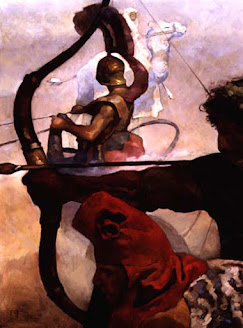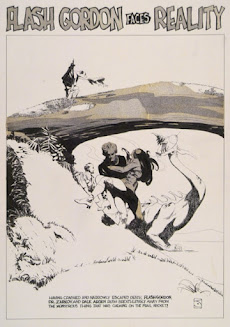“I am a romantic and a painter and I love women… The female form just reflects light so simply and beautifully.”
Jeffrey Catherine Jones was a legendary illustrator, and, so far as I know, is the only trans woman artist on this list. She drew for Fantastic Magazine, Heavy Metal, DC Comics, King Comics, Gold Key Comics, Skywald Publications, Creepy, Eerie, Vampirella, and Wally Wood’s Witzend. She also illustrated over 150 book covers in her career, with genres including not only fantasy and sci-fi, but romance, humor, mainstream fiction, horror, and Westerns. She was quite prolific, painting a cover a week for many years. From 1972-75 Catherine drew her own comic strip, titled Idyl, which was published in National Lampoon Magazine. Her next strip, I'm Age was published in Heavy Metal in the '80's. She won the World Fantasy Award in 1986. She was also nominated four times for a Hugo Award, and also almost won a Chelsea Award. Spectrum named her a grand master. Five books showcasing her work have been published. Frank Frazetta, of whom Catherine was a disciple, called her 'the greatest living artist.' In 2012 Maria P. Cabardo created a documentary titled Better Things: The Life and Choices of Jeffrey Catherine Jones.

'Portrait of Jeffrey Catherine Jones' by Michael Netzer
Catherine was born Jeffrey Durwood Jones, in Atlanta Georgia. Her father was a soldier, who mostly worked overseas. According to
WomeninComics.Fandom.Com, "She was "a geeky kid", excelling in science and making rocket fuel in a lab in her basement, and was a member of the chess and Latin clubs." The blog, Muddy Colors posted an excerpt from Catherine's autobiography where she talked about her childhood,
"I believe in Atlanta, Georgia in the year 1947. That was before I met my father. I was three and he seemed a myth. My dad, I was told, was somewhere in a place called Germany, busy dropping bombs on people. I didn’t believe in him.
"In the mid-forties Atlanta was beginning to build itself into a place that I’d never again recognize. What I remember were ancient buildings, ancient trees, and a drumming sound that “the South Shall Rise again.”
"I lived beneath the daily fragrance of impossible magnolias and a giant holly-tangle that shook with screaming, evening bats.
"There remain impressions along with false memories with which I’ve been storied. I was born into the great southern house of my grandfather, resplendent with ivy-carpeted yards, privet taller than he and clay tennis courts, dry and powdery, spreading quietly behind gardens of Victorian wildness. I remember garages of mystery: red painted wooden buildings with doors that never opened. Five cars wide, they spread across a gray cracked pavement where I learned, first with stroller, then with uncertain feet, to walk.
"My grandmother moved in and out of rooms like a shadow, leaving a glimpsed but not always certain presence. In the earlier part of this century she had been an outspoken suffragette, marching and rallying womankind to awaken. Now she rarely spoke."
Jeffrey went to Georgia State College where she got a degree in geology. She started drawing comics while in college, and published her first one in 1966 for Witzend. While there, she met and started dating Mary Louise Alexander, who would later become a comic book writer for Marvel, and help co-create characters like Cable and Apocalypse. The couple married in 1966, had a daughter, Juliana, the next year, and moved to New York City together, where Catherine began a career as an illustrator. Unfortunately, the couple soon divorced in the early '70's.
Catherine disliked drawing mainstream comics, although she loved the medium itself. She made her own comic strips -
Spasm,
Idyl, and later
I'm Age. She described them in a 2001 interview (Ringgenberg,
The Comics Journal, 2011):
"My general intent in both strips was to explore the difference between men and women. The only real difference between Idyl and I'm Age is that in the former men were generally represented by animals or objects, and in the latter, there were no males present. Idyl was intended as satire and whimsy. One art director and one editor, who met me each month with puzzled faces, continued to remind me that National Lampoon was a humor magazine, "As long as YOU laugh," they finally said. So each month I would go in laughing. I also must admit that I love to draw nude women.”
'Uncharted Stars'
Catherine also grew disgusted with commercial illustration, calling it immoral, and began devoting herself to personal, fine art projects, starting around 1978-9. She later said (Ringgenberg, The Comics Journal, 2011):
"Years ago I had goals (to get to this or that place), and when I did I found that all I wanted to do was art. So I have given up goals. When I was young, my passion was art, eventually comic book and fantasy art. I've seen a lot of people lose their childhood passions, not only for art but for life--just getting squeezed. My passion was and is my art. However, there was a time when I became aware that I might be losing it. Having used my ability to draw to buy approval from my childhood peers, I entered the real world with my "cash" in my pocket. I wanted to be published so badly that in the beginning I took on a lot of work that I hated. Ah, but maybe a million people would see it and love me. I lived in fear. What happened? I found that the more I went to the drawing board or the easel to do work I hated, the less I wanted to go there. I was losing my joy, and I found eventually that my joy was more important than approval. I began to get "difficult to deal with" and began to lose jobs. I became determined to, well, not so much "have it my way," but to do work I loved. It's not so easy to pursue, or even know what your heart's desire may be."
'Age of Innocence'
Catherine came out as trans in 1998, at 54 years old. She said she's always wanted to be a girl, since childhood and began hormone replacement therapy. People react differently to a person transitioning, and one topic of confusion has to do with names and pronouns. When awarding her with a grand master title, Spectrum author, Arnie Fenner, contacted her to ask how the award should read. Arnie later wrote, "I had asked Jeff how he wanted his nameplate to read on his Spectrum Grand Master Award and it says, per his instructions, “Jeffrey Jones.” 'That’s how people know me,' he said. 'That’s how I want to be remembered.'”
In 2001 Catherine suffered a mental breakdown, and lost both her home and studio. This lasted until 2004, when she got her life back on track, and began painting again, right up to her death. She died at 67 of severe emphysema, bronchitis, and coronary disease, after a week-long coma. She passed away surrounded by family.
'Tarzan'
'Tarzan'
'Dark Angel'
'World's Desire'
'Kong'
'The Seeker'
'The Zero Stone'
'Spring In Gold'



















































Comments
Post a Comment